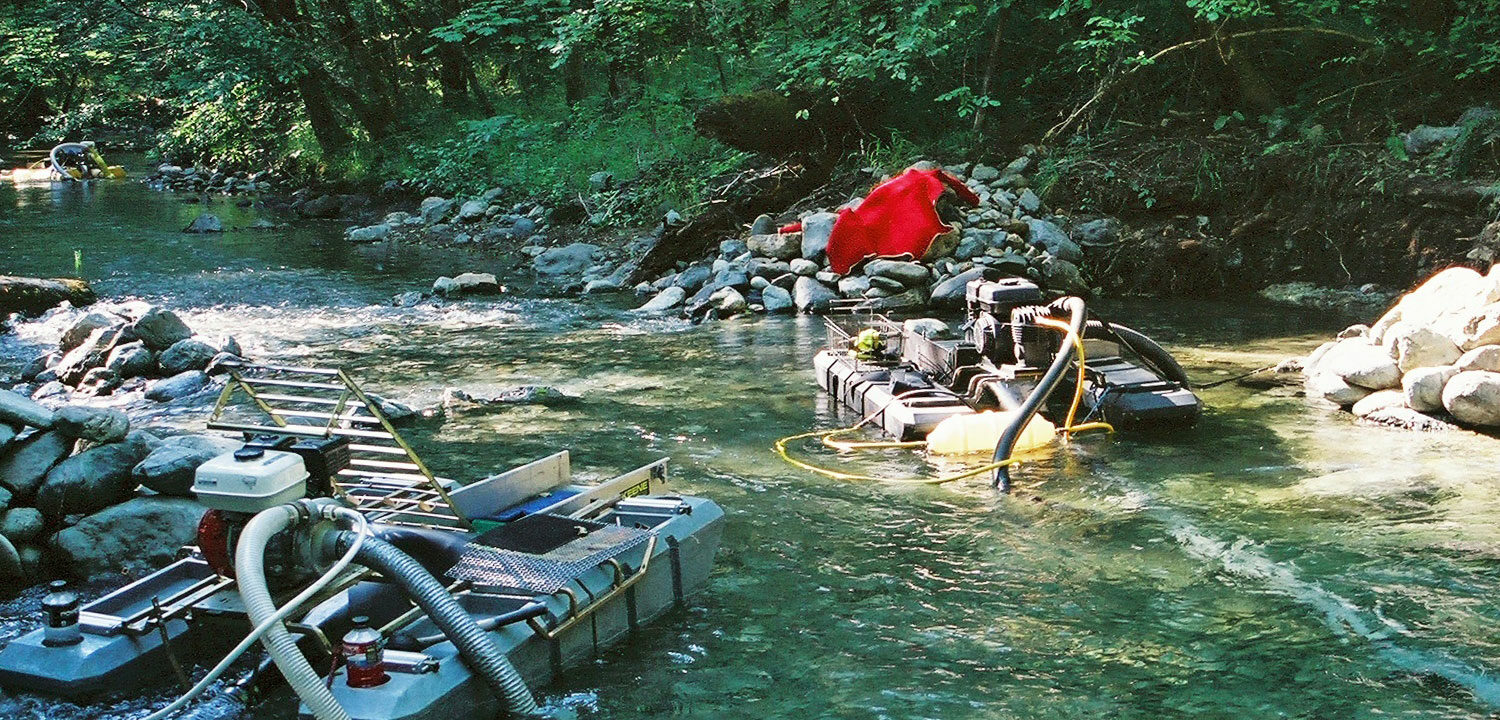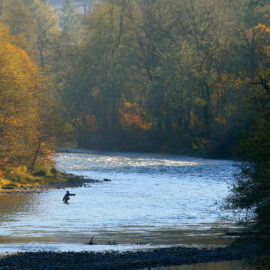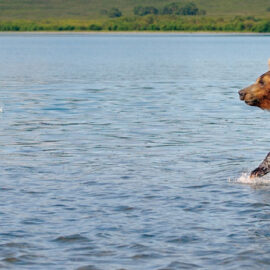With a bill to reform suction dredge mining making its way through the Oregon Legislature, our science director details the mining practice’s harmful impacts.
By Matthew Sloat
Suction dredge mining is practiced by recreational miners who vacuum up streambeds in search of gold. California banned the practice in 2009, sending miners north into Southern Oregon. The recent spike in suction dredge mining in Oregon caused the state to put a temporary ban on the practice. Now, the Oregon Legislature is considering a permanent solution.
The impacts of suction dredge mining on stream habitat, fish, and other wildlife are well documented in science publications. Studies demonstrate negative effects on streambed scour, fish habitat, and direct mortality of federally-listed fishes. There’s also potential for impacts to human health, as legacy mercury from historical gold mining in streams is remobilized into waters used for drinking and recreation.
Here are some of the key research findings on suction dredging relevant for Oregon’s salmon, steelhead, and trout populations:
Suction dredge mining disturbs key habitat for juvenile salmon and trout.
By removing or displacing cobbles, boulders, and logs, suction dredge mining impacts important cover habitat for juvenile salmon and trout. Cover habitat is essential for juvenile salmon and trout as they avoid predators and avoid being washed downstream during winter floods. The amount and quality of cover habitat in streams is a key factor in the productivity of many of Oregon’s salmon and trout populations.
Suction dredge mining reduces the reproductive success of Pacific salmon.
Where dredging vacuums up streambeds, it destabilizes the streambed gravels that salmon use for spawning. Spawning gravel that has been disturbed by suction dredge mining is known to erode at a higher rate than in undisturbed areas, thereby washing away and killing incubating salmon eggs. These effects can occur well after suction dredge mining activity has ceased.
Suction dredge mining results in direct mortality to incubating eggs and juvenile fish.
Eggs and juvenile fish suffer high mortality when vacuumed into suction dredges. This is particularly important for species like cutthroat trout and steelhead that spawn in late winter and whose eggs may incubate into summer. It is also important for bull trout, a federally listed species that spawns in very cold streams and whose eggs and larvae can remain in the streambed into summer.
Suction dredge mining increases sedimentation in downstream fish habitats.
Suction dredge mining can result in levels of fine sediments (silts and sands) in downstream habitats that are as high as 10 to 20 times above normal background conditions. Fine sediments impact fish habitat by filling in the crevices between boulders and cobbles that otherwise provide cover for juvenile salmon and trout, and by smothering spawning gravels with sands and silts that prevent adequate oxygen from reaching incubating eggs. Fine sediments can also decrease the abundance of aquatic insects, a major prey source for juvenile fish. Studies have documented a reduction in aquatic insect communities in areas affected by suction dredge mining in comparison to those areas not affected by mining.
Suction dredge mining can release hazardous forms of mercury.
Suction dredge mining uncovers hazardous forms of mercury left over from historical mining practices. Although suction dredging captures some mercury from the streambed, much of the mercury is washed downstream. The sediment plume below suction dredge operation can have mercury concentrations exceeding water quality standards, creating a health hazard for fish, wildlife, and humans.
Based on impacts documented in the scientific literature, we believe that suction dredge mining poses a threat to the state’s salmon strongholds, including the Illinois, North Fork John Day, and Wenaha. The impacts of continued suction dredge mining pressure on salmon strongholds may make conservation and recovery of the state’s salmon resources more difficult and more costly. The legislature would be smart to consider these costs as it weighs new laws on suction dredging.
Relevant research:
- Harvey, C., and T. E. Lisle. 1998. Effects of suction dredging on streams: a review and an evaluation strategy. Fisheries 23(8):8-17.
- Bustard, R. and Narver, D.W., 1975. Aspects of the winter ecology of juvenile coho salmon (Oncorhynchus kisutch) and steelhead trout (Salmo gairdneri). Journal of the Fisheries Board of Canada, 32(5), pp.667-680.
- Solazzi, F., Nickelson, T. E., Johnson, S. L., & Rodgers, J. D. (2000). Effects of increasing winter rearing habitat on abundance of salmonids in two coastal Oregon streams. Canadian Journal of Fisheries and Aquatic Sciences, 57(5), 906-914.
- Harvey, C., and T. E. Lisle. 1999. Scour of chinook salmon redds on suction dredge tailings. North American Journal of Fisheries Management 19:613-617.
- Horizon Water and 2009. California Department of Fish and Game Suction Dredge permitting Program: literature review on the impacts of suction dredge mining in California. Report prepared for the Department of Fish and Game, Redding.
- Somer, L. and Hassler, T.J., 1992. Effects of suction-dredge gold mining on benthic invertebrates in a northern California stream. North American Journal of Fisheries Management, 12(1), pp.244-252.
- Harvey,C., 1986. Effects of suction gold dredging on fish and invertebrates in two California streams. North American Journal of Fisheries Management, 6(3), pp.401-409.
- Information about the North American Stronghold Partnership can be found here: https://wildsalmoncenter.org/work/science/stronghold-approach/




